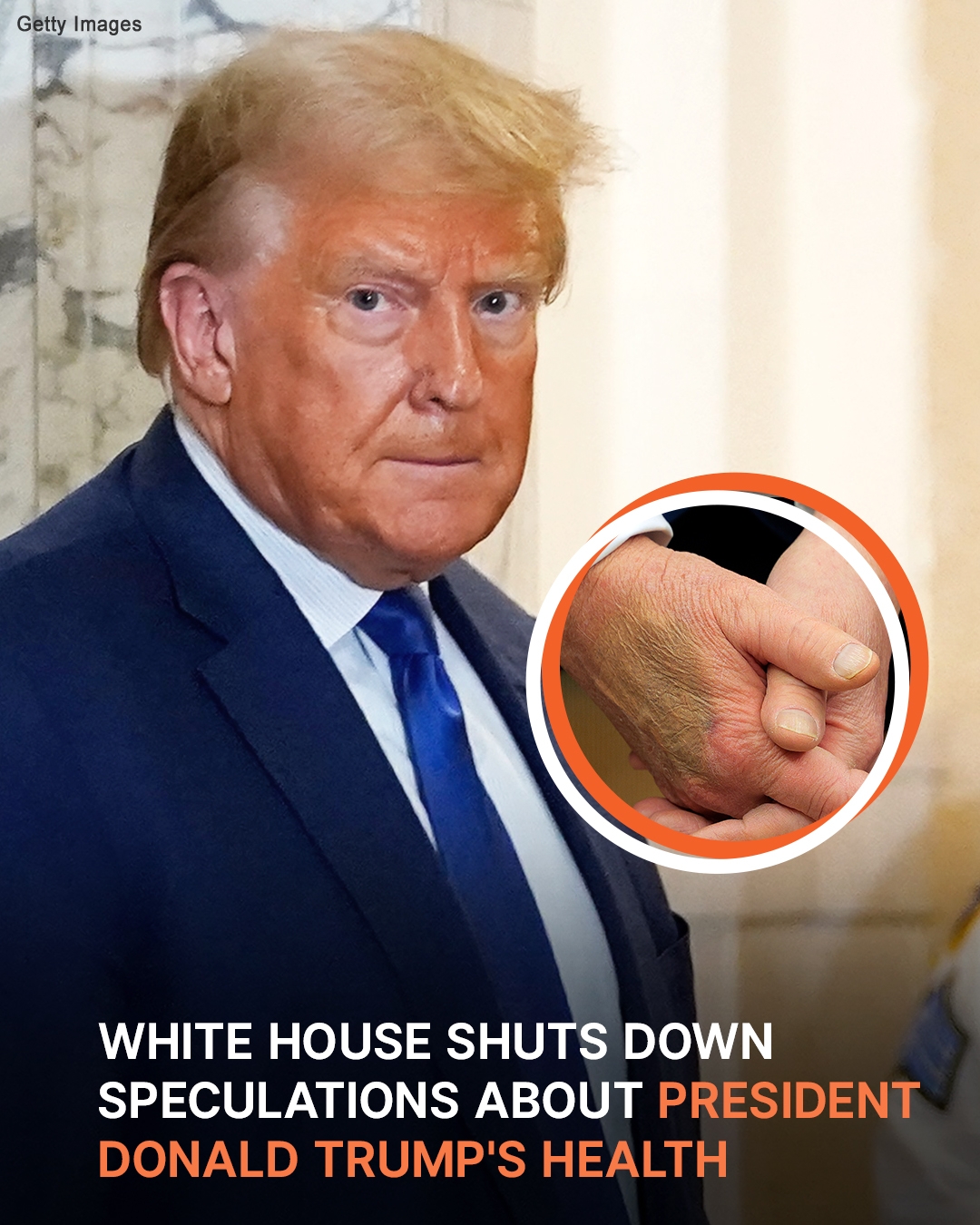The White House shared Donald Trump’s medical report just over a month after he was seen with a large bruise on one of his hands during a high-profile meeting.
On April 11, 2025, President of the United States (POTUS) Donald Trump underwent his annual physical examination at Walter Reed National Military Medical Center. The exam was conducted and overseen by Captain Sean P. Barbabella, D.O., the Physician to the President.

U.S. President Donald Trump arriving for a presentation ceremony for the Commander-in-Chief Trophy to the U.S. Naval Academy in Washington, D.C., on April 15, 2025. | Source: Getty Images
According to the official memorandum released by the White House on April 13, the comprehensive assessment included diagnostic tests, lab work, urinalysis, and consultations with fourteen medical specialists. The results, publicly released with Trump’s consent, indicate that he remains in excellent health.
At 78 years and 10 months old, Trump stands 75 inches tall and weighs 224 pounds. His vital signs appeared within normal ranges — his resting heart rate was measured at 62 beats per minute, blood pressure at 128/74 mmHg, and oxygen saturation at 99% on room air. His body temperature registered at 98.6°F.

Donald Trump attends a watch party during the Iowa Republican presidential caucuses in Des Moines, Iowa on January 15, 2024. | Source: Getty Images
The report goes on to provide a meticulous overview of the POTUS’ physical condition, noting that his visual acuity, visual fields, and intraocular pressure were all within normal limits, with a dilated eye examination confirming healthy ocular function.
Examination of his head, ears, nose, and throat revealed no major abnormalities, though the summary did acknowledge scarring on his right ear — a remnant of a past gunshot wound. His hearing was reported to be intact.

Donald Trump holds his first campaign event since a man carrying a rifle was arrested near where Trump was playing golf in Flint, Michigan on September 17, 2024. | Source: Getty Images
Both the thyroid and lymph nodes were recorded as normal, and vascular imaging of the carotid arteries from the previous year showed no concerning findings, rendering further testing unnecessary.
Trump’s lungs were described as clear upon examination, and a CT scan of his chest supported those findings, with no signs of pathology present.

Donald Trump walks towards Marine One on the South Lawn of the White House in Washington, D.C., on March 28, 2025. | Source: Getty Images
Cardiovascular testing, which included an electrocardiogram and an echocardiogram, demonstrated a regular heart rate and rhythm, normal heart sounds, and no abnormalities in heart structure or function. His ejection fraction — a critical measure of the heart’s pumping ability — was described as healthy, with no impediments to blood circulation in the extremities.
The abdominal and gastrointestinal evaluations were similarly uneventful, with ultrasound results showing no abnormalities. However, the report did revisit the findings of a July 2024 colonoscopy, which identified both diverticulosis and a benign polyp.

Donald Trump arrives to speak during a “Make America Wealthy Again” trade announcement event in Washington, D.C., on April 2, 2025. | Source: Getty Images
While these findings were non-urgent, gastroenterology has recommended that another colonoscopy be scheduled in three years for continued surveillance. The genitourinary system was declared normal, and a musculoskeletal assessment confirmed full range of motion in his joints and muscles, with healthy blood flow and no swelling.
Neurologically, Trump underwent a battery of cognitive and functional tests, all of which returned normal results. These included the Montreal Cognitive Assessment, on which he scored a perfect 30 out of 30.
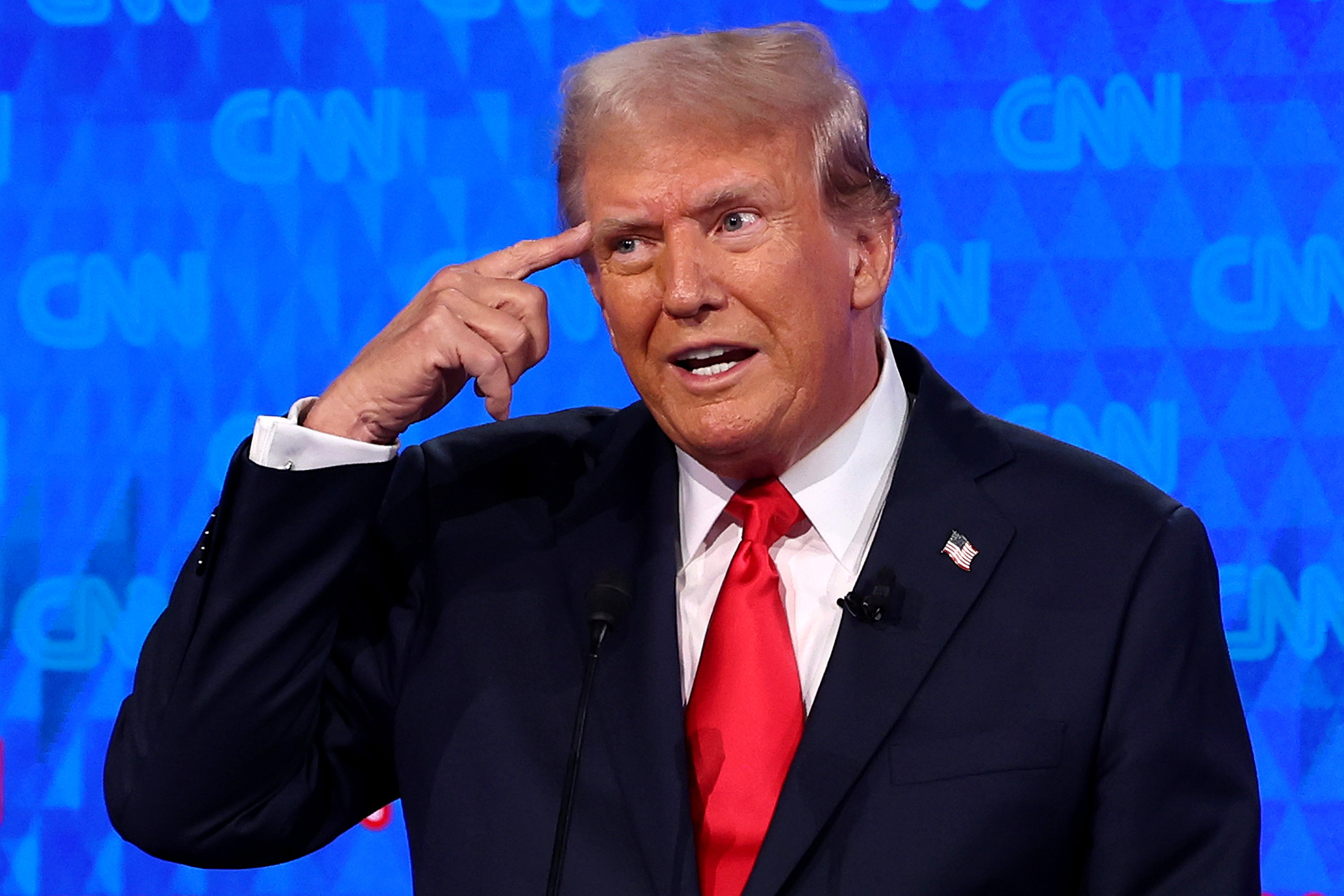
Donald Trump participates in the CNN Presidential Debate at the CNN Studios in Atlanta, Georgia on June 27, 2024. | Source: Getty Images
His mood and mental health were evaluated through standardized screening tools — the PHQ-9 for depression and GAD-7 for anxiety, both of which placed him firmly within the normal range.
Dermatologic tests were also conducted, which indicated minor sun damage and only a few benign lesions, with “no concerning lesions or growths” identified. Additionally, the report lists the medication Trump takes currently, such as medicine for cholesterol control, cardiac prevention, and a cream for a skin condition.

Donald Trump gives a thumbs up after stepping off Air Force One upon arrival at Joint Base Andrews in Maryland on April 6, 2025. | Source: Getty Images
Overall, the memo affirms that Donald Trump is in robust physical and cognitive condition. His active lifestyle, marked by public appearances, press engagements, and frequent participation in golf, is credited with maintaining his well-being.
The report concludes by affirming that the POTUS is fully fit to carry out the duties associated with the office of Commander-in-Chief and Head of State.

Donald Trump plays golf during the Official Pro-Am Tournament ahead of the LIV Golf Invitational Series event in Bedminster, New Jersey on August 10, 2023. | Source: Getty Images
While the White House report paints a picture of robust health, it arrives on the heels of weeks of mounting public scrutiny. Attention surrounding Trump’s physical condition surged after images emerged from his February 24 meeting with French President Emmanuel Macron.
In official press photographs, a prominent, dark bruise was clearly visible across the back of Trump’s right hand, its size and discoloration difficult to overlook.

French President Emmanuel Macron speaking with Donald Trump during a meeting in Washington, D.C., on February 24, 2025. | Source: Getty Images
Close observers noted what appeared to be an attempt to conceal the mark with makeup — a detail that only intensified questions about its origin.
Pressed for clarity, White House press secretary, Karoline Leavitt, offered a brisk explanation. She attributed the bruising to Trump’s busy schedule, consisting of public engagements during which he shakes hands regularly. Leavitt brushed aside the concern as a sign of his ceaseless work ethic.

A close-up of Donald Trump’s bruise. | Source: Getty Images
“President Trump is a man of the people. His commitment is unwavering, and he proves that every single day,” she asserted. With Trump having become the oldest U.S. president to take office at the time of his second inauguration in January, concerns about age-related vulnerability were difficult to dismiss.
Medical experts have pointed out that the appearance of bruising, especially in individuals of advanced age, is not unusual and often results from natural physiological changes.

Emmanuel Macron and Donald Trump shaking hands. | Source: Getty Images
According to the Mayo Clinic, the aging process thins the skin and reduces the protective fatty layer that cushions blood vessels. This makes capillaries more susceptible to breaking from even minor bumps or pressure.
When these tiny vessels rupture, blood seeps into the surrounding tissue, leading to the visible discoloration commonly recognized as a bruise.
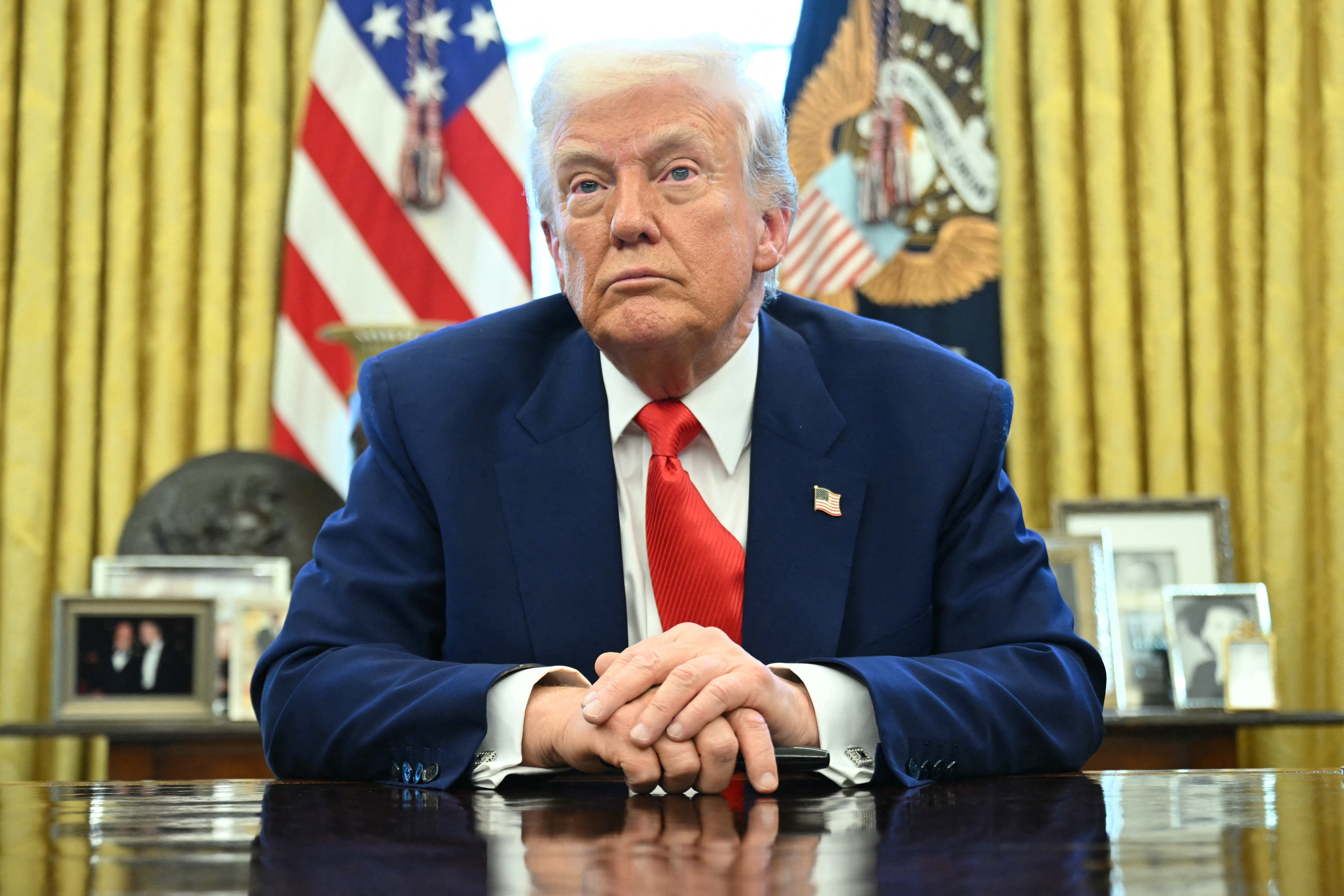
Donald Trump looks on after signing an executive order in the Oval Office of the White House in Washington, D.C., on April 9, 2025. | Source: Getty Images
Yet, age alone may not account for the severity of the bruise that drew such widespread attention. Medical sources, including the Cleveland Clinic, also identify blown veins as a potential cause, typically the result of needle insertion during procedures such as blood draws or intravenous treatments.
Such vascular injuries can produce large, localized bruising, especially in patients with more fragile veins. This possibility stirred additional speculation, especially among those who recalled a similar incident in the fall of 2020.

Donald Trump walks on the South Lawn of the White House in Washington, D.C., on April 13, 2025. | Source: Getty Images
At that time, Trump was photographed with bandages on his right hand shortly after he was diagnosed with COVID-19, prompting questions about whether he had been receiving IV fluids.

Donald Trump speaking during a rally in Washington, D.C., on October 10, 2020. | Source: Getty Images
The disclosure of Trump’s medical report comes after he declined to release a comprehensive one during the 2024 presidential campaign, despite public calls for transparency and repeated promises to do so.
Instead, his campaign pointed to earlier letters from his physician and from Dr. Ronny Jackson, who treated him after the July 13, 2023 assassination attempt in Pennsylvania.
One statement released by physician Bruce Aronwald on November 20, 2023, coinciding with former President Joe Biden’s 81st birthday, declared that, as of September 2023, Trump was in “excellent” health. Aronwald’s note did not reference any tests or specific treatments.
In contrast, former Vice President Kamala Harris’ campaign published a detailed two-page health summary in October 2024. Authored by her physician, Dr. Joshua Simmons, it included medical history, lifestyle details, and a family health overview.
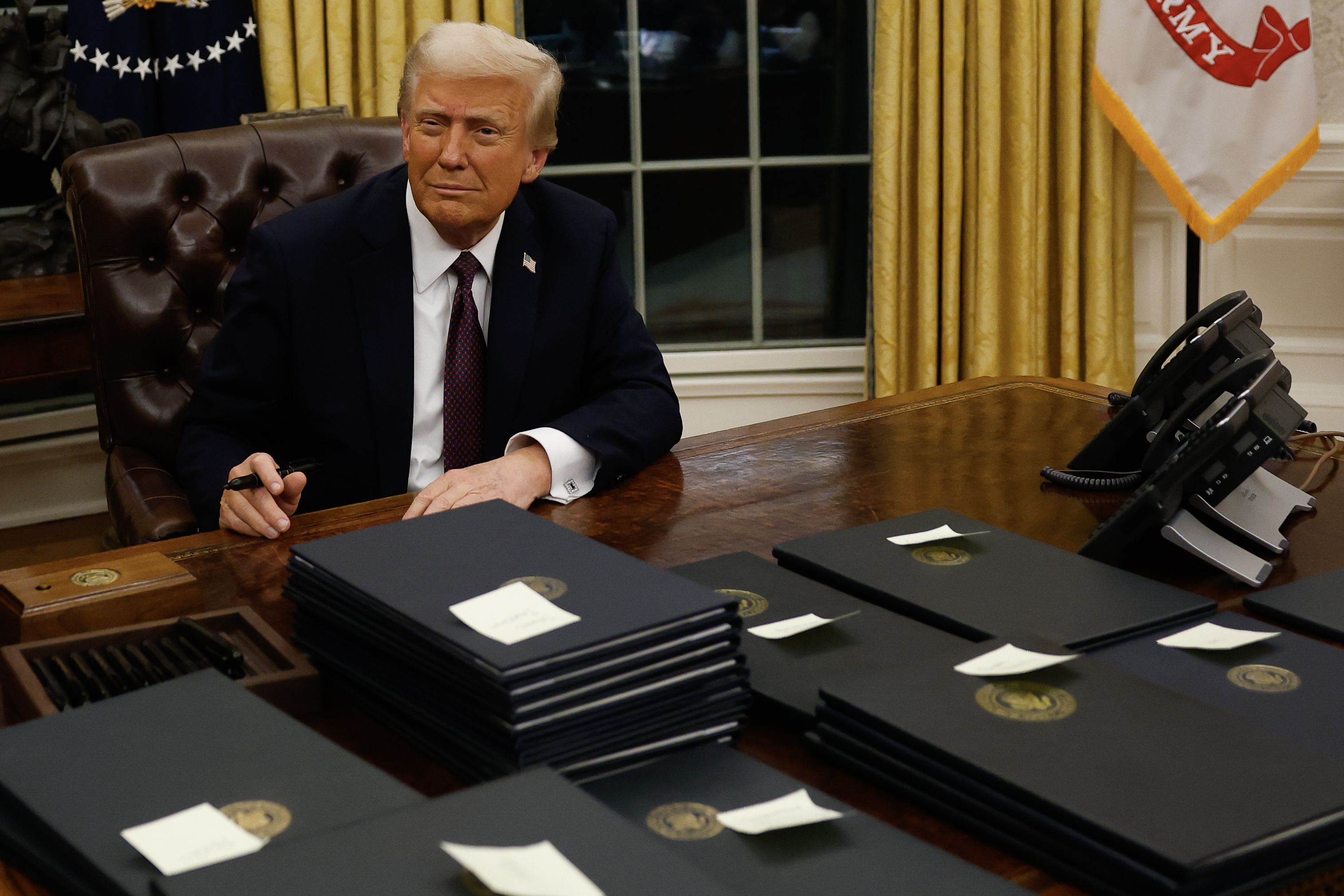
Donald Trump signs executive orders in the Oval Office in Washington, D.C., on January 20, 2025. | Source: Getty Images
Simmons wrote that Harris “possesses the physical and mental resiliency required to successfully execute the duties of the Presidency.” The timing of that release placed added pressure on Trump’s team, which had avoided releasing any comprehensive report during the election.

Donald Trump welcoming the 2025 College Football National Champions from Ohio State University to the White House in Washington, D.C., on April 14, 2025. | Source: Getty Images
No new clinical documentation was provided during that period. On October 12, 2024, Trump Campaign Communications Director Steven Cheung issued a statement defending the decision.
“President Trump has voluntarily released updates from his personal physician, as well as detailed reports from Dr. Ronny Jackson, who treated him after the first assassination attempt. All have concluded he is in perfect and excellent health to be Commander in Chief,” it read.

Donald Trump gestures as he speaks during a rally in Doral, Florida on July 9, 2024. | Source: Getty Images
“He has maintained an extremely busy and active campaign schedule unlike any other in political history, whereas Kamala Harris has been unable to keep up with the demands of campaigning,” Cheung added. “Her schedule is much lighter because, it is said, she does not have the stamina of President Trump.”
The campaign also circulated Dr. Jackson’s earlier assessments from his time as White House physician, including the 2018 cognitive screening. That result was frequently cited by Trump and his allies, particularly during moments when his opponents’ mental acuity was questioned.

Donald Trump arrives for his campaign rally at the Trump National Doral Golf Club. | Source: Getty Images
No new cognitive exam was publicly reported between 2018 and 2025. Dr. Jackson, who served as White House physician under both Presidents Barack Obama and Trump, was long regarded as one of Trump’s most vocal defenders on matters of health.
During his time as presidential physician, Jackson publicly praised Trump’s condition and famously stated that the president “could live to be 200 years old” if he improved his diet. Trump later attempted to nominate Jackson for Secretary of Veterans Affairs, a move that failed amid controversy and a whistleblower complaint.

Donald Trump exits the Oval Office and walks to Marine One on the South Lawn of the White House in Washington, D.C., on October 1, 2020. | Source: Getty Images
In July 2022, two years before Trump’s latest physical, the U.S. Navy formally reclassified Jackson’s retirement rank. Originally retired as a rear admiral (lower half), Jackson was retroactively demoted to the rank of retired Navy captain following a Pentagon inspector general’s investigation that substantiated multiple allegations.
The report documented multiple violations, including inappropriate conduct while on duty, use of prescription sleep aids, drinking alcohol with subordinates, and making sexually inappropriate remarks to a female staff member.
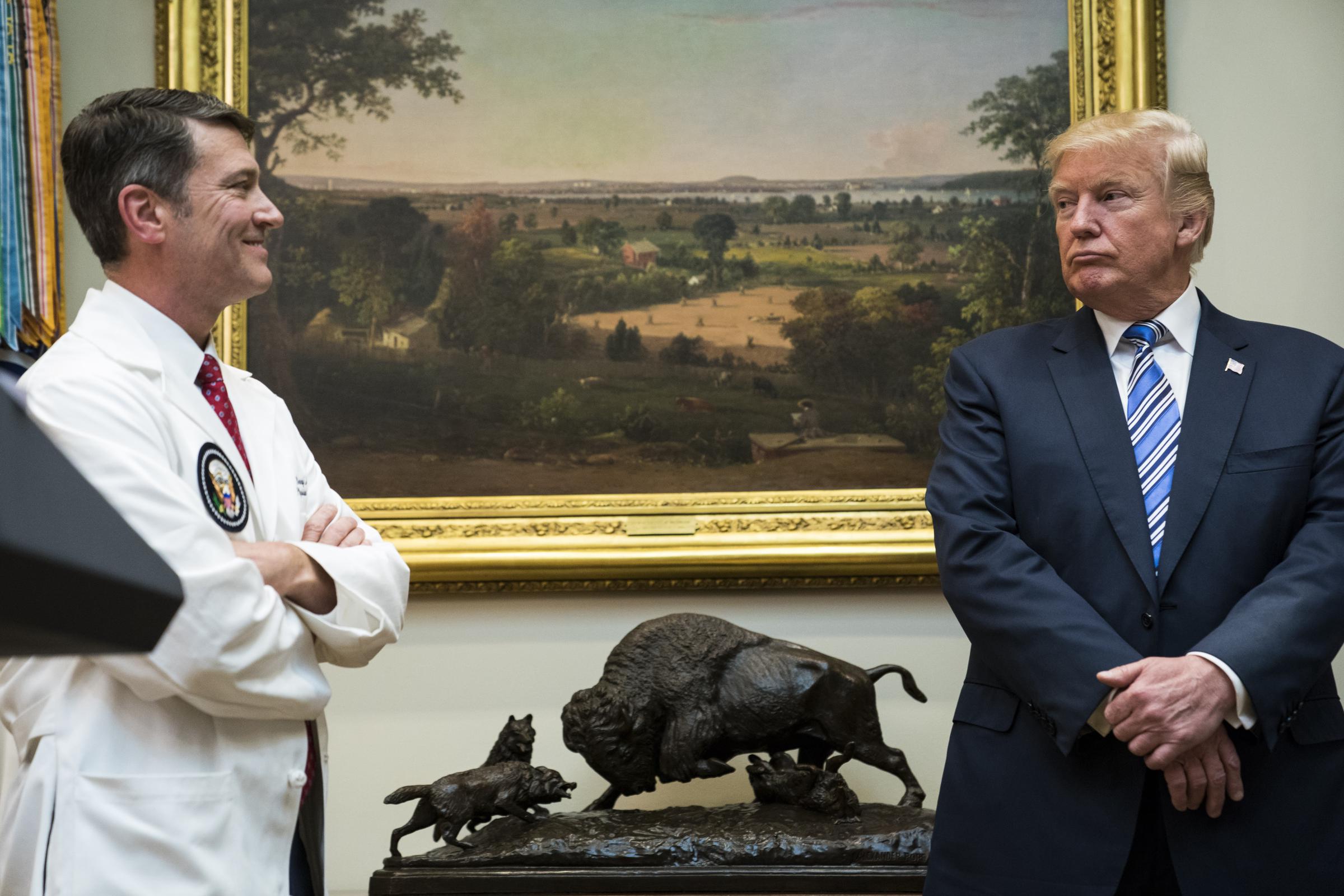
Donald Trump and Dr. Ronny Jackson during a Veterans Affairs Department “telehealth” event in the Roosevelt Room of the White House on August 3, 2017. | Source: Getty Images
Navy spokesperson Lieutenant Commander (Lt. Cmdr.) Joe Keiley stated that Jackson’s conduct was “not in keeping with the standards the Navy requires of its leaders and, as such, the secretary of the Navy took administrative action in July 2022.”
The demotion also affected Jackson’s pension and status in military circles. Nonetheless, Jackson has continued to refer to himself publicly as a rear admiral. His official congressional biography and public statements have not reflected the updated rank.
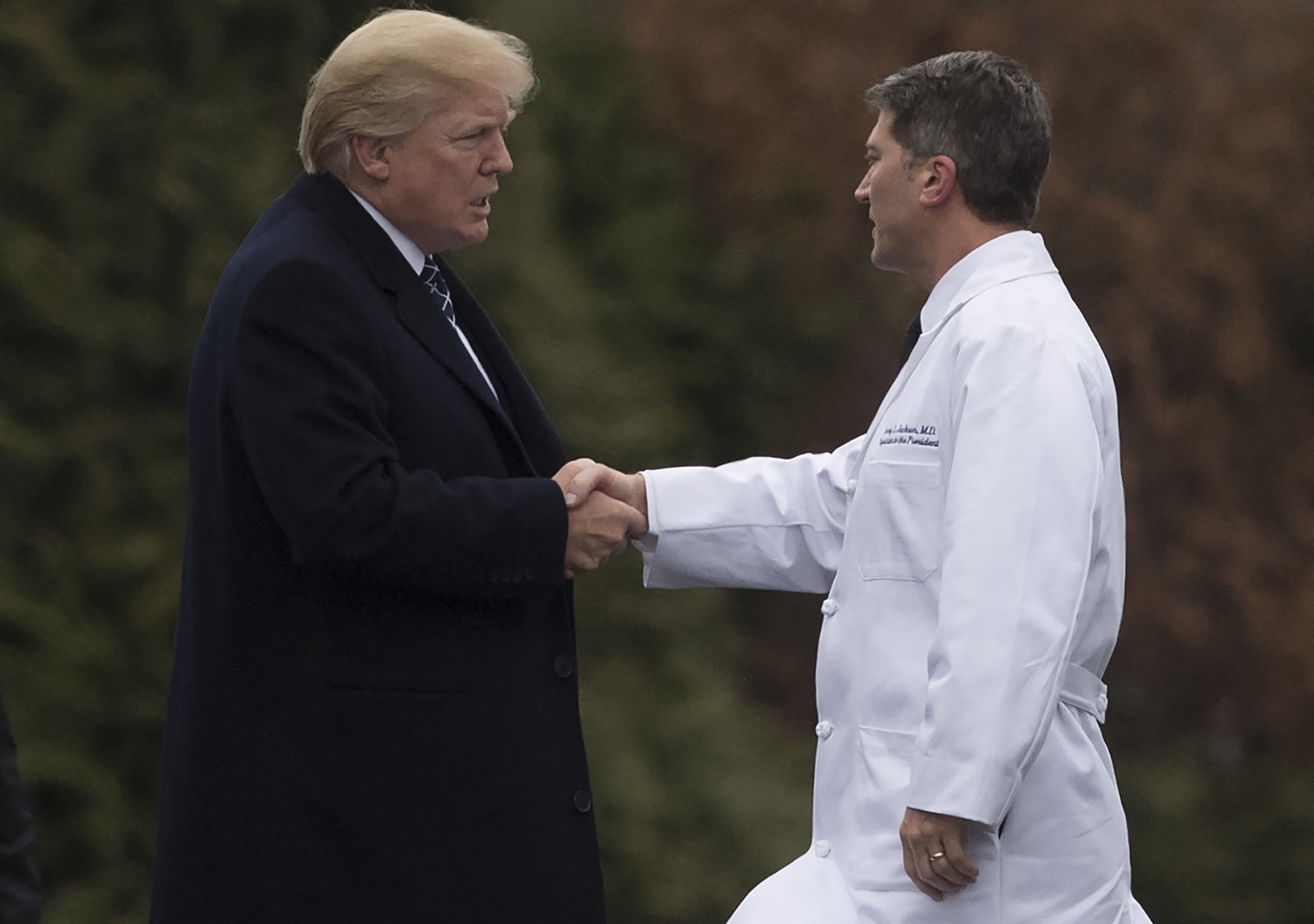
Donald Trump shakes hands with Dr. Ronny Jackson, following his annual physical at Walter Reed National Military Medical Center in Bethesda, Maryland on January 12, 2018. | Source: Getty Images
Commenting on this discrepancy, military analyst Katherine L. Kuzminski stated, “While it is possible that others will mistakenly refer to him as ‘Admiral’ in perpetuity, he himself should not make that mistake.” Despite the Navy’s administrative action, Trump continued to publicly praise Dr. Jackson in the months that followed.
At the Conservative Political Action Conference in August 2022 — just days after Jackson’s demotion became effective — Trump referenced him during his remarks, without acknowledging the change in rank.

Donald Trump attends a “Save America” rally in support of Arizona GOP candidates on July 22, 2022. | Source: Getty Images
“He was an admiral, a doctor, and now he’s a congressman, and I said, which is the best if you had your choice? And he sort of indicated doctor because he loved looking at my body, it was so strong,” Trump said. “He said I’m the healthiest president that’s ever lived. … I said, I like this guy.”

Donald Trump waves at the 100th annual Veterans Day Parade and wreath-laying at the Eternal Light Flag Staff in New York on November 11, 2019. | Source: Getty Images
By then, Jackson had already launched his congressional career and emerged as a visible surrogate for Trump, particularly on the topic of health.
He continued to make public appearances on conservative media and at campaign events, questioning the fitness of Biden and highlighting the cognitive exam he administered to Trump in 2018.
While Jackson publicly vouched for Trump’s fitness and dismissed questions about his cognition, a very different account came from inside the Trump family. In November 2024, Fred C. Trump III, the president’s nephew, shared his perspective on what he described as a pattern of cognitive decline in the Trump family.

The Trump Family pose for a group portrait during Easter Sunday events at the Mar-a-Lago club in Palm Beach, Florida on April 16, 2006. | Source: Getty Images
He also voiced concerns about parallels he had observed in the president himself. “I see it in parallel with the way my grandfather’s decline was. If anyone wants to believe that dementia did not run in the Trump family, it’s just not true,” the POTUS’ nephew said.

Donald Trump speaking at the 2025 Republican Issues Conference in Doral, Florida on January 27, 2025. | Source: Getty Images
He recalled that their grandfather, Frederick Trump Sr., was diagnosed with Alzheimer’s disease and began showing signs in the 1980s. The president’s nephew also named other relatives — Trump’s cousin, John Walter, and sister, Maryanne Trump Barry — as having exhibited similar symptoms before their deaths.
He claimed that during a 2023 encounter at Mar-a-Lago, the president “just looked disoriented, and he kept repeating something to me time and time again when I had met him.” In the same interview, the POTUS’ nephew said he noticed changes in Trump’s speech patterns and public behavior.

Donald Trump taking a question from a reporter during a news conference in Washington, D.C., on January 21, 2025. | Source: Getty Images
“He has also had no inhibitions about cursing in front of anybody,” he said, acknowledging that while Trump had “always cursed,” his recent communication felt more aggressive and erratic. The nephew also cited an exchange concerning his son, William, who was born with a rare genetic mutation.
According to the POTUS’ nephew, when the diagnosis was explained, Trump responded, “Not our genes.” The Trump campaign dismissed the interview as “completely fabricated and total fake news.” No other members of the Trump family publicly addressed the claims beyond that statement.

Donald Trump during an executive order signing in the Oval Office in Washington, D.C., on February 11, 2025. | Source: Getty Images
The April 2025 report states that neurological testing was conducted. But while the memo contains more clinical detail than previous releases, it does not reference a formal cognitive test, nor does it address the claims made by Trump’s nephew.
Polling data, published in March 2025 by Monmouth University, showed that 51 percent of registered voters expressed confidence in the president’s physical and mental stamina, compared with 32 percent who said the same about Biden.

Donald Trump is sworn into office as Melania Trump holds the Bible in the U.S. Capitol Rotunda in Washington, D.C., on January 20, 2025. | Source: Getty Images
The decision to release the memo mere months into Trump’s second term has drawn renewed attention to the results and the strategy behind their timing.
What remains under continued scrutiny is not just the president’s current condition, but the broader pattern of how his health has been assessed, described, and publicly managed across two presidencies.

